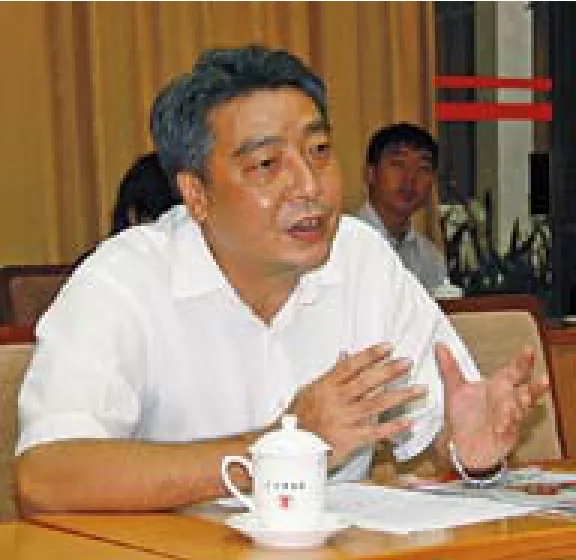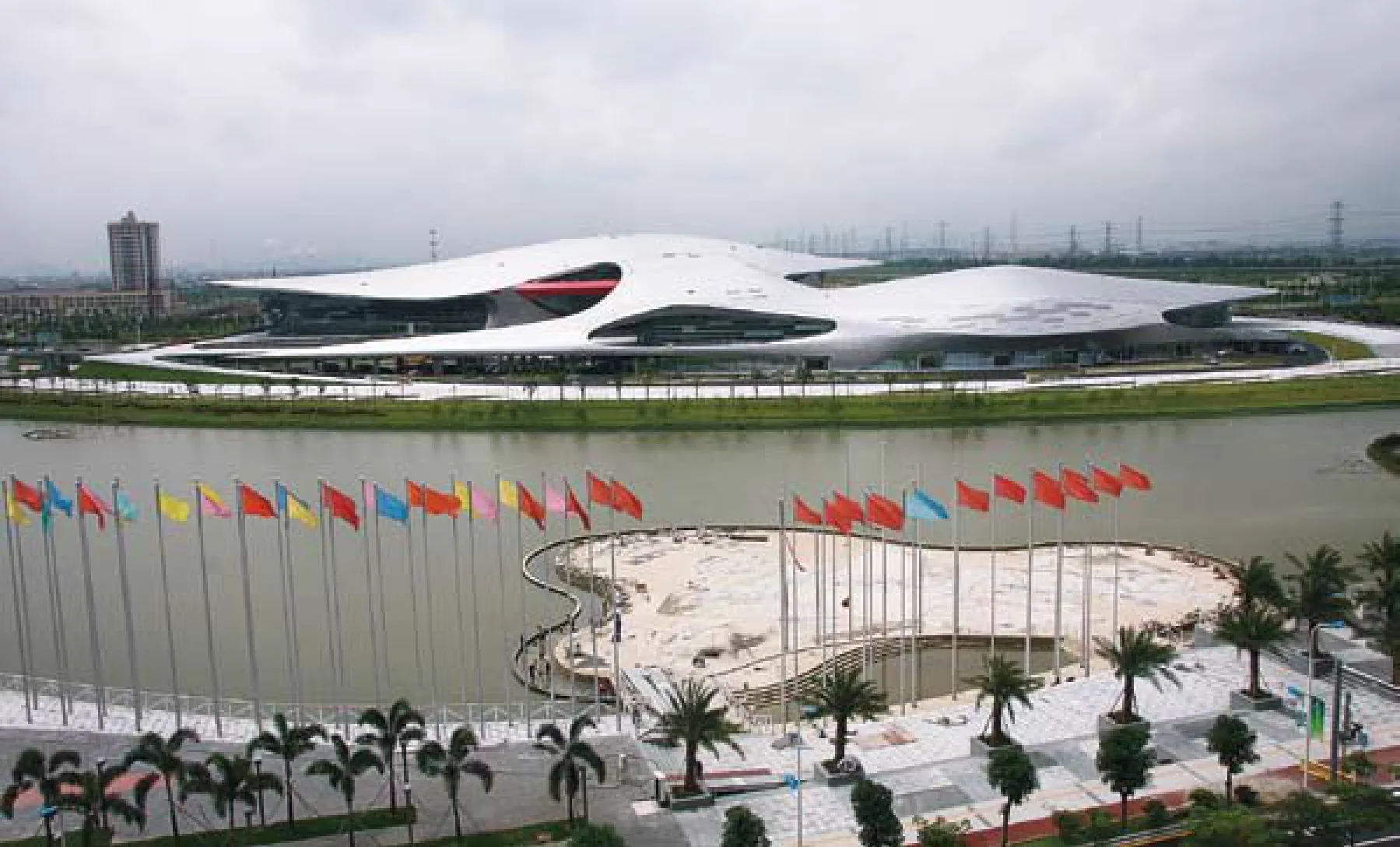Last Step to the Asiad
2011-10-14ByDINGWENLEI
By DING WENLEI
Last Step to the Asiad
By DING WENLEI
Organizers of the 16th Asian Games in Guangzhou sprint to the finish line
The pieces of the upcoming 16th Asian Games, to be held on November 12-27, are falling into place as the host city Guangzhou prepares for an in fl ux of athletes and sports spectators.
Spirits are high among local officials in Guangzhou, south China’s Guangdong Province, especially Vice Mayor Xu Ruisheng,who has worked tirelessly to ensure the games are successful for the city and the country.

Xu Ruisheng, Vice Mayor of Guangzhou and Executive Deputy Secretary General of Guangzhou Asian Games Organizing Committee
“I always prefer to say we are moving on‘as scheduled’ instead of ‘we are completely ready,’” said Xu, who is also the Executive Deputy Secretary General of Guangzhou Asian Games Organizing Committee(GAGOC).
A number of obstacles can arise before the curtain is drawn for such a large event like this, Xu said, but GAGOC and the entire city is prepared for anything.
“The level of preparation and emergency plans we have in place will make all the difference,” Xu said with bloodshot eyes,evidence of sleepless nights of planning.
New interior decorations and equipment were recently installed in all event venues and facilities. Teams of operators were sent to each venue for run-through operations—40 trial runs in total—and all venues are expected to be ready for the November event.
“Sure, problems will arise when policies and plans are put to the test during the trial period, but we’ll make adjustments accordingly and in another month or so be fully prepared for the event,” he said.
Asiad’s appeal
Also called the Asiad and held every four years, the Asian Games as an intercontinental event are different from international sports events and provide sufficient opportunities for unique and diversified cultures across Asia to show their ability, said Xu.
With this in mind, GAGOC and the Olympic Council of Asia (OCA) organized the Road of Asia program, during which a GAGOC delegation visited National Olympic Councils in 37 Asian countries and regions. GAGOC will hold a series of exhibitions on Asian countries’ culture and heritage before and during the event.
The 16th Asian Games will include as many as 42 sports, the most in the Asiad’s history. Of the total, 14 are non-Olympic sports popular in Southeast Asian countries, which in particular will “ensure each Asian country takes an interest in participating,” he said.
Match schedules won’t be released until the third round of athlete application is completed on September 30. Even so, statistics from the fi rst two rounds indicate Guangzhou will attract more athletes than any previous host city, with participation from all 45 countries and regions in Asia.
Ticket sales will peak in October after the event schedule is fi nalized. But Xu said making fi nancial ends meet remains GAGOC’s goal,since they cannot be as ambitious as Beijing Olympic organizers in terms of ticket sales.

READY TO GO:The Guangdong Olympic Tennis Center is one of the 12 new venues constructed for the 16th Asian Games.Interior decoration and equipment installment were recently completed in all venues and facilities for run-through operations
“Compared with the Beijing Olympics in 2008, the Guangzhou Asian Games is less appealing to an international audience. It has no quali fi cation rounds, and the venue for the opening and closing ceremonies can hold an audience of a little more than 20,000, only one third of the Bird’s Nest (the National Stadium) capacity,” he said.
Guangzhou will stage the opening and closing ceremonies on Haixinsha Island in the Pearl River, allowing artists to incorporate elements of the surrounding landscape into their performance.
“The local culture, as well as all of Asia’s diversi fi ed cultural heritage, will be demonstrated at this special venue,” Xu said.
Olympic Councils of Asian countries are entrusted with overseas ticket sales for the event, and in total the event is expected to attract more than 2 million people, he said.
Designed in China
Xu, a former architect before becoming vice mayor of Guangzhou in 2003,encouraged the use of Lingnan-style architecture in the design work for the Asian Games’ venues. Lingnan-style architecture,widespread in Guangdong Province and Guangxi Zhuang Autonomous Region, is known for its gorgeous and heavy decorations, compact layout and design suiting the humid local climate.
“Because the window designs maximize the use of natural light and air fl ow, much of the traditional architecture is actually low carbon,” Xu said. “Venues built with such designs for the games can host daytime sports events without extra lighting.”
Xu also said GAGOC promoted the use of energy-ef fi cient technologies in these venues. Low-carbon construction materials were also used in the new venues.
When choosing designers for the venues,GAGOC didn’t court big name architects from around the world, but instead offered young, local designers the opportunity to demonstrate their talent and creativity.
“We were happy to see Chinese architects, mostly educated and growing up after China adopted reform and open up policies in the late 1970s, win out in our international biddings for venue design,” he said,excited and leaning slightly forward. “They are China’s design-making pride, with works that are in no way inferior to foreign bidders.”
Design work for the Asian Games Town was a joint-project between China and the United States, but much of the work was done by domestic architects in their 30s and 40s.
Independent marketing
Using the 2008 Beijing Olympics as a blueprint, the 16th Asian Games will serve as another of China’s independent marketing for a large sports event.
The OCA signed an agreement with GAGOC on February 1, 2008, allowing Guangzhou to become the first host city to buy out exclusive marketing rights for the Asian Games.
So far, it’s proven to be a “good bargain,”with revenues expected to hit record highs,Xu said.
Japanese advertising giant Dentsu was the sole marketer and broadcaster for the previous three Asiads in Bangkok, Thailand;Busan, Korea; and Doha, Qatar.
“It’s hard for the host city to have autonomy in marketing when the sole agent wants half or one third of the pro fi ts from the market development,” he said.
In the meantime, the financial crisis in late 2008 has posed a challenge for GAGOC’s ability to successfully market the games. But GAGOC has an experienced and diligent team—nearly 50 GAGOC staff members worked for the Beijing Organizing Committee for the Games of the XXIX Olympiad.
“We have to work harder and more innovatively in order to make both ends meet,and thanks to participation from state-owned and private enterprises, we have signed 47 sponsorship contracts,” Xu said. “And time at the table [with potential sponsors] is never time lost.”
Taiwan Beer, which holds more than 70 percent of market shares of the Taiwan market, was named the of fi cial beer partner of the 16th Asian Games. “It will serve as an example of successful interaction between two markets across the Taiwan Straits, especially if the event helps boost its sales and recognition among mainland customers,”he said.
In addition, the Hong Kong Jockey Club invested in the construction of an equestrian fi eld for the event and would manage the fi eld independently after the event.
“From working with the club we have learned many standard practices, and the cooperation offered us a chance to examine our own administration,” he said.

NEW LANDMARK:The Asian Games Town Gymnasium upon completion
